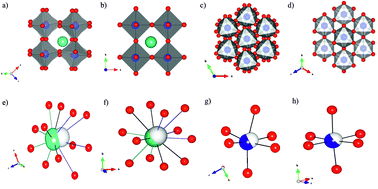Chemical control of octahedral tilting and off-axis A cation displacement allows ferroelectric switching in a bismuth-based perovskite†‡
Abstract
Bi(Fe2/8Mg3/8Ti3/8)O3 (BFTM) is a member of a small class of pure Bi3+ A site perovskites which are stable without recourse to high pressure synthesis. BFTM is polar in the R3c space group, but ferroelectric switching of the polarisation is not attainable in bulk ceramics. Formation of solid solutions with BaTiO3 produces enhanced functional behaviour. The composition 0.75Bi(Fe2/8Mg3/8Ti3/8)O3–0.25BaTiO3 displays ferroelectric hysteresis loops and piezoelectric response (high field d33 of 85 pC N−1 at 0.1 Hz and low field d33 of 16 pC N−1). This change in functional behaviour is associated with significant changes in the average structure, where the rhombohedral distortion is reduced and transformed to a pseudo-cubic R3m space group, as substitution of the larger Ba2+


 Please wait while we load your content...
Please wait while we load your content...